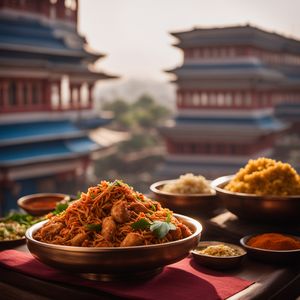
Dish
Thalipeeth
Thalipeeth is made by mixing different flours like jowar, bajra, rice, and besan along with spices like cumin, coriander, and turmeric. The dough is then flattened into a pancake-like shape and cooked on a tawa. Thalipeeth is a rich source of protein, fiber, and essential vitamins and minerals. It is gluten-free and vegan, making it a perfect option for people with dietary restrictions. Thalipeeth is usually served with a dollop of butter or ghee and is best enjoyed with a cup of hot tea or coffee.
Origins and history
Thalipeeth has been a staple breakfast dish in Maharashtra for centuries. It is believed to have originated in the rural areas of the state where people used to make it using locally available ingredients. Thalipeeth is also known as "bhajaniche thalipeeth" as it is often offered as prasad during religious ceremonies.
Dietary considerations
Gluten-free, vegan
Variations
Thalipeeth can be made with different flours and spices to suit individual tastes. Some variations include adding grated vegetables like carrots, onions, and spinach to the dough. Thalipeeth can also be made with a stuffing of spiced mashed potatoes or paneer.
Presentation and garnishing
Thalipeeth is usually served on a plate with a dollop of butter or ghee on top. It can be garnished with fresh coriander leaves or grated coconut. The pancake-like shape of Thalipeeth makes it easy to stack and serve.
Tips & Tricks
To make Thalipeeth, make sure to knead the dough well to ensure that all the ingredients are well combined. Use a non-stick tawa to cook the Thalipeeth to prevent it from sticking to the pan. Thalipeeth can also be made in advance and stored in an airtight container for up to 2 days.
Side-dishes
Thalipeeth is usually served with a side of fresh yogurt or pickle. It can also be enjoyed with a spicy chutney made from mint or coriander leaves.
Drink pairings
Thalipeeth is best paired with a hot cup of tea or coffee. It can also be enjoyed with a glass of fresh buttermilk or lassi.
Delicious Thalipeeth recipes
More dishes from this category... Browse all »

Abud
Arab cuisine

Aish baladi
Egyptian cuisine

Aish merahrah
Egyptian cuisine

Ajwain paratha
Indian cuisine

Aloo naan
Indian cuisine

Amdo balep
Tibetan cuisine

Amritsari kulcha
Indian cuisine

Anda paratha
Indian cuisine
More cuisines from this region...

East Indian cuisine
Spicy and tangy flavors, Uses a lot of herbs and spices (mustard seeds, cumin, coriander), Uses a lot of fish and seafood which give it a unique flavor

North East Indian cuisine
Spicy, Tangy, Flavorful, Unique

North Indian cuisine
Spicy, Tangy, Aromatic, Sweet, Uses a lot of oil and ghee

Other Indian cuisine
Spicy, Tangy, Sweet, Sour, Pungent

South Indian cuisine
Spicy, Tangy, Sweet, Savory, Aromatic

West Indian cuisine
Spicy, Bold, Tangy, Sweet, Savory

